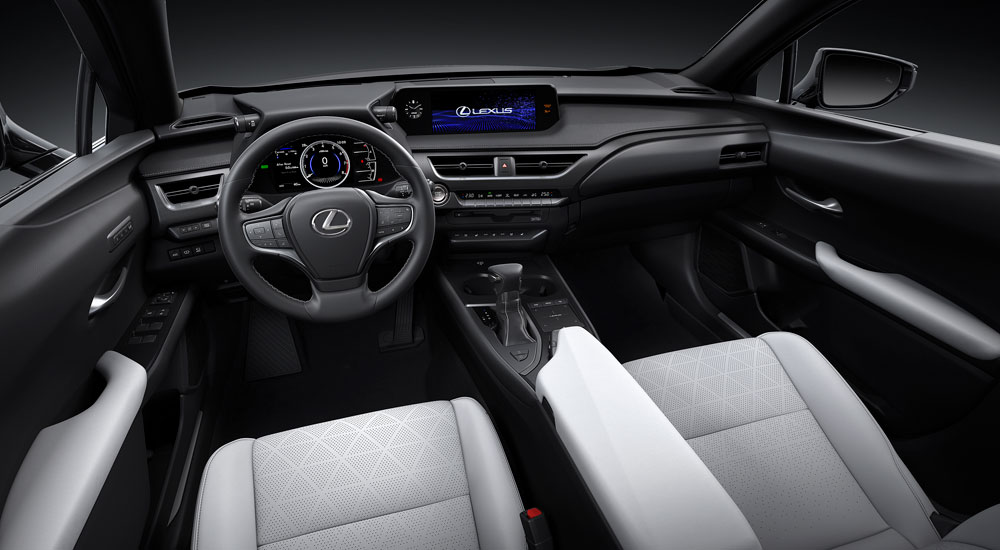How the expression go, “You don’t know what you want until you see it?” Thanks to the introduction of the 2019 Lexus UX, that idiom makes much more sense. That was my initial impression of Lexus’s compact SUV/Crossover – a vehicle that fills an empty spot in the Lexus lineup that most consumers probably didn’t notice was there in the first place. The very concept of the UX was exciting; compact crossovers can be loads of fun to drive and have the power to re-frame your driving expectations. The fact that Lexus even decided to produce a smaller vehicle than the NX led to a plethora of possibilities I was eager to experience.
So how does the Lexus UX fair? It’s far more stylish than the competition and performance wise it has its charms. It’s small, there is no doubt about that, and for the price, space might be something that consumers actual yearn for in the end. But space isn’t what the UX is about. The UX is about creating a new experience and how that experience is received depends on the driver (and the trim level).
What I dig about the 2019 Lexus 250h.
Design in Motion – It’s got more style than BMW’s x1 and the Mercedes-Benz GLA, two vehicles that are roughly the same size as the UX. The UX barely beats out Audi’s Q3 in terms of style, but beauty is always in the eye of the beholder. What’s undeniable though is that the UX draws inspiration from it’s Toyota brethren to create an eye-catching aesthetic that is clearly meant to appeal to a younger audience. It’s visually spunky and exudes a sense of speed with its mixture of swooping lines and sharp angles – quintessential design elements of the Toyota/Lexus brand. I would have preferred that Lexus pull back a little on the gaping maw that is the hexagonal-laden grille but again, it’s a trademark of the brand. I dig the way plastic fenders above the wheel well lurch back towards the rear of the UX, adding to that sense of motion. Indentions along the side of the body give it dimension but only leave room for small rear passenger windows. While one long brake light bar across the rear is a popular trend, especially among crossovers, the UX’s version is less annoying than say the Mitsubishi Eclipse Cross.

Just Enough Cargo Space – Don’t expect to pack much more than a hefty pile of groceries into the cargo area of the 2019 UX but that should be no surprise and when utilized practically, it’s more than enough space for “urban” living. I’m a new parent and I’m used to lugging around a good-sized stroller in the trunk of my car. I was sure it wouldn’t fit in the cargo area of the small UX with it’s 17 cubic feet of cargo space. But to my pleasant surprise, it did fit. There wasn’t much room for anything else but at least the UX gives you the option to play with the space.

Hybrid Model That Does the Job – The h at the end of the 250h stands for hybrid and taking the UX through a combination of city and highway driving results in better than expected results when it comes to range and performance. This version of the UX comes with a 2.0L four-cylinder hybrid engine that produces 181 horsepower. It’s paired with an electric motor attached to the rear axle and will power the UX up to 45 mph, after which the traditional gas power engine takes over. The transition between the two is seamless and the electric portion of the engine works as buttery smooth as you would expect it to. Lexus says the hybrid version of the UX should get the driver 41 mpg in the city with 38 mpg on the highway with a combined 36 mpg. During my testing, I came closer to 34 mpg combined, which was close enough considering that city highway driving often meant intentionally accelerating at short bursts.

Snazzy Interior Like Only Lexus Can Deliver – With such a unique design aesthetic on the outside, Lexus could have could gone in a variety of directions when it comes to interior design but they chose wisely; the cabin of the UX is snazzy, well thought out and luxurious without sacrificing fun. All the interior elements felt nicely constructed and the layout of the dash is futuristic in structure. It’s easy to fall in love with the beautifully narrow infotainment screen nestled high on the dash, leaving room for a minimalist center stack (not to mention a classy little analog clock.) I’m not a fan of touchpad media controls but Lexus produces one of the better examples on the market. The physical volume controls live as a dial that you flick with your thumb as your hand sits on the armrest behind the trackpad. Using this volume dial – and a host of other essential infotainment system controls also on this handrest – takes some practice. Even after a week, I still had to look down to make sure I was manipulating the correct controls.

What Made Me Say: “Meh”
Understated Performance – While the Lexus UX might purr like a kitten when it traverses city streets it doesn’t come close to growling when pushed to perform – even in the F Sport model. Considering the size of the UX, I was expecting it to be a rocket off the line and progress up the gear line nimbly, but instead its a bit unimpressive from 0-60 (10 seconds) and finicky when accelerating aggressively. Don’t get me wrong, the ride is smooth and satisfactory for most every-day occasion – it just doesn’t have the “ompfh” I was expecting. Lexus is obviously gearing the UX towards the fuel conscious, especially in the hybrid version, but the added weight the electric motor adds isn’t doing the F Sport package any favors.
An over-reliance on computers – Driving modes have never felt more important than they do in the UX. With the driving mode knob dialed to Normal, I never quite felt like I was experiencing the UX’s full capabilities when it comes to handling and overall performance. Kicking the car into Sport and Sport+ adds some semblance of weight and overall response felt much more agile. But there is a lot of digital adjustments going on below the surface that contributes to an “artificial” driving experience. Steering wheel feedback is almost non-existent and I never felt as grounded as I would have liked.

Inexpensive from Certain Angles – A crossover is a crossover and a Lexus is still a Lexus – a luxury brand that is priced as such. With the introduction of the UX, Lexus has entered a new tier of affordability; starting at just $32,000 for the base model, the UX 200 falls below the most inexpensive Lexus vehicle, the NX 300. It’s also cheaper than the competition but only in the luxury category. Across the entire industry, crossovers are increasingly becoming more sophisticated and many come equipped with options and amenities once regulated only to luxury brands. Despite being fashionable, the UX might indeed be too late to the party.
The Urban Explorer
There is so much to like about the 2019 Lexus UX 250h that its shortcomings might be easily overlooked…for the correct consumer. While the UX stylings are refreshing, they may be too far out of the box for luxury shoppers who will gravitate to the subdued (and boring) stylings of competitors. Mid-range consumers in the market for a crossover might enjoy aspects like the snazzy interior but the UX’s entry-level price tag might be too steep – particularly for a vehicle this size. The ideal consumer of the UX is an urban city dweller who doesn’t need an abundance of cargo space and enjoys sitting in their car. It’s fitting then that Lexus says the UX stands for “Urban Explorer” because an urban setting is exactly where this vehicle will be most at home.





